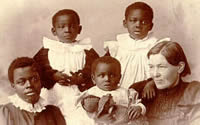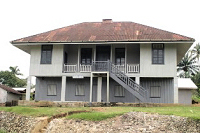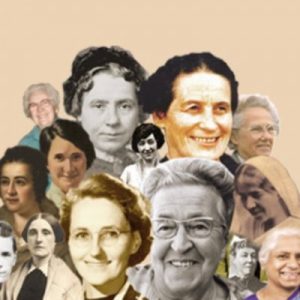Mary Slessor 1848-1915
Mary Slessor was born on 2nd December 1848 in Gilcomston, a suburb of Aberdeen, the second of seven children, only four of whom survived childhood. Her father, Robert Slessor, originally from Buchan, was a shoemaker to trade. Her mother, from Oldmeldrum, was a deeply religious woman of sweet disposition, who had a keen interest in missionary work in the Calabar region of Nigeria.
In 1859, the family moved to Dundee in search of work. Mrs. Slessor became a member of the Wishart Church, named after the nearby Wishart Arch from which Protestant martyr George Wishart had reputedly preached to plague victims during the epidemic of 1544.
Mary’s father became an alcoholic and was unable to continue his shoemaking work. He finally took a job as a mill labourer. Mrs. Slessor was determined to see her children properly educated, and the young Mary not only attended Church but, at the age of eleven, began work as a “half timer” in the Baxter Brothers’ Mill. Mary spent half of her arduous day at a school provided by the mill owners, and the other half in productive employment for the company. Thus began a harsh introduction to the work ethic which was to dominate her life.
By the age of fourteen, Mary had become a skilled jute worker. The life of a weaver, no longer with the benefit of company schooling, was daunting by modern standards. Up before 5 a.m. to do the housework, Mary worked from 6 a.m. to 6 p.m. with just an hour for breakfast and lunch.
Fortunately, Mary had benefited significantly from her rudimentary education. More importantly, she developed an intense interest in religion and, when a mission was instituted in Quarry Pend (close by the Wishart Church), Mary volunteered to become a teacher. Later, the mission moved to Wishart Pend, where the Church still stands, and so began a formative period in Mary’s life during which she learned to cope with both physical and mental hardship.
The story is told of how she stood her ground against a local gang, who swung a metal weight on a string closer and closer to her face. This stalwart young woman defied the gang by obtaining their agreement that, should she not flinch, then all her tormentors would join the Sunday School class. Mary triumphed, and gained experience which she would later exploit in her contacts with even more threatening tribes in a distant land.
Strangely, although entranced by the accounts of work in Nigeria outlined in the “Missionary Record”, this courageous woman doubted her own ability to perform similar deeds, describing herself as “wee and thin and not very strong”. Eventually, however, she applied to the Foreign Mission Board of the United Presbyterian Church, effectively offering her life to the people of the Calabar region. After a brief period of training in Edinburgh, Mary set sail in the S.S. Ethiopia on 5th August 1876, and arrived at her destination in West Africa just over a month later. She was 28 years of age, red haired with bright blue eyes shining in enthusiasm for the daunting task ahead. Some of the old hands in Calabar might have been excused for questioning whether she would last her first full year.
Portuguese mariners first visited the present day Nigeria in the 15th century to pursue trade with the kingdom of Benin, which straddled the land between Lagos and the Niger delta. By the year 1811, Wilberforce’s great anti-slavery reforms started to take effect, and so the slave trade, which had disrupted society and government, finally began to crumble. In 1861, Britain seized Lagos in order to preserve her trading interests, the first of a series of colonial initiatives which led to the establishment of the Nigerian Protectorate in 1914. When Mary Slessor arrived, she was to witness one of the most turbulent periods in the history of this process.
The culture and customs of her new flock are well described in Charles Partridge’s book, “Cross River Natives”. Witchcraft and superstition were prevalent in a country whose traditional society had been torn apart by the slave trade. Human sacrifice routinely followed the death of a village dignitary, and the ritual murder of twins was viewed by the new missionary with particular abhorrence. Her dedicated efforts to forestall this irrational superstition were to prove a resounding success, as photographs of Mary with her beloved children testify.
In this primitive society, women were treated as lower than cattle, and Mary was so successful in raising their standing in society that she may be considered as one of the pioneers of women’s rights in Africa. She also became fluent in the Efik language, so that she might use humour and sarcasm to reinforce her arguments. Unlike most missionaries, she lived in native style and became thoroughly conversant with the language, the culture and customs, and the day-to-day lives of those she served so well.
Unfortunately it was dangers other than those from aggressive natives and wild animals that faced missionaries from a relatively healthy Western European environment. It was not until 1902 that Sir Ronald Ross was awarded the Nobel Prize for his work on the Anopheles mosquito and its role as a host for the deadly malarial parasite. This knowledge was too late for Mary Slessor and her colleagues. Like lambs to the slaughter, they came to a country with its river mists and overpowering heat, where diseases and infections were legion, and they succumbed in their hundreds to the very fevers from which the modern traveller is mercifully spared.
Their average life expectancy was just a few years, and those who survived and returned home often endured recurring fevers and ill-health for the rest of their lives. In letters reproduced here, Mary bravely makes light of her experiences, but the horrors of forty years of debilitating suffering may be clearly discerned through the surface humour and stoicism. In the early years of the 20th century, some remedies and precautions were becoming available, and Mary provided vaccination against the dreaded smallpox, and set up mission hospitals for treating illnesses and injuries suffered by the native peoples.
Mary’s dedicated work with the people and her almost total integration with them culminated in an official request by the Governor that she combine her missionary activities with an administrative position as a Member of the Itu Court. Her letters to Charles Partridge chronicle this period of colonial expansion. Roads were being driven into the interior, and military expeditions were starting to make use of motor vehicles.
Untold dangers faced all those involved in these hazardous enterprises, and Mary Slessor, though ever keen to discount her own perilous situation, retained a pragmatic attitude to the dangers facing lesser mortals. In one letter she urges that the expedition should include a “Maxim” [machine gun].
She was constantly urging the Foreign Mission Board in Edinburgh to finance extensions of her work in the interior. The trading markets which she had enthusiastically encouraged attracted people from far afield, and her attempts to reach out to them were the natural consequences of these contacts. Gradually the money was forthcoming and, as new missionaries took over responsibility for the posts vacated by Mary, she was able to move ever further into the heartland. Her courage in braving the hostility provoked by these incursions is legendary.
The recurring illnesses and general hardships which she faced as a matter of course all took their toll on this redoubtable woman. By 1915, her physical strength had greatly declined, and the woman who had once thought nothing of all-night treks through the rain forest was finally reduced to travelling in a hand-cart propelled by one of her assistants. On the 13th January 1915, after an excruciating and prolonged bout of fever, Mary Slessor died. In his biography of 1980, James Buchan described her as the “Expendable Mary Slessor”. Expendable she may have been, but few have given so much of themselves to so many, and under such appalling conditions.
The grave of Mary Slessor, marked by an imposing cross of Scottish granite, is in the heart of the country she served so well. She was accorded a state funeral and, in 1953, the new head of the Commonwealth, Elizabeth II, made her own pilgrimage to the graveside. Mary Slessor is still remembered in Dundee, as in her adopted homeland, and there is a growing world-wide interest in her work.
The finest tribute was from those of her own who knew her best. To them she was “Mother of All The Peoples” or, more simply, “Ma”.
The collection of Books and Letters and Slessor Source Material in Dundee Central Library’s Local Studies Department and in the City Archives may be viewed during the normal opening hours of the Department.
The Mary Slessor Foundation aims to continue the work of Mary Slessor, albeit in modern form.
For more on Mary Slessor click here.
- A Pathetic Incident by Miss Slessor
- From a letter written by Miss Slessor acknowledging a parcel of work from St. Luke’s, Montrose.
- Miss Slessor’s Return to Darkest Africa.
- No More Sorrow by Miss Slessor
- Some Thoughts Written in Mary Slessor’s Bible
- The Awakening up the Cross River, by Miss Slessor.
- Triumphing over Superstition by Miss Slessor



Leave a Reply